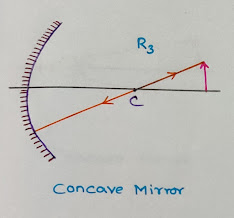Lab Activity:
Experiment to observe various types of images formed by a concave mirror and their characteristics
- Place the concave mirror on V-stand, a candle and meter scale as shown in the below figure.
- Keep the candle at different distances from the mirror (say 10cm to 80cm) along the axis by moving the paper or screen.
- Find the position where you get the sharp image on the paper by taking care that flame should be above the axis of the concave mirror and paper should be below the axis.
- Note down your observation in the following table
|
Observation No. |
Distance of the candle from the mirror (Object Distance) u |
Distance of the paper from the mirror (Image Distance) v |
Bigger/Smaller Or Enlarged/Diminished than the object |
Inverted or Erected |
|
|
|
|
|
|
|
|
|
|
|
|
|
|
|
|
|
|
|
|
|
|
|
|
|
S.No. |
Position of the object |
Position of the image |
Nature of the image |
|
1 |
At Infinity |
At F |
Real, inverted and highly diminished |
|
2 |
Between P and F |
Behind the mirror |
Virtual, erect and enlarged |
|
3 |
At Focus F |
At Infinity |
Real, inverted and enlarged |
|
4 |
Between C and F |
Beyond C |
Real, inverted and enlarged |
|
5 |
At C |
At C |
Real, inverted and of the same size |
|
6 |
Beyond C |
Between F and C |
Real, inverted and diminished |
Questions related to the lab activity:
- Is it inverted or erect, enlarged or diminished?
- What do you infer from the above table?
- Why only at point A?
- Where is the base of the candle expected to be in the image when the candle is placed on the axis of the mirror?
- During the experiment, did you get any positions where you could not get an image on the screen?
Construction of Images using Ray Diagrams:
1. An incident ray passing through the centre of curvature (C):
2. An incident ray parallel to principal axis:
3. An incident ray passing through the Focus:
4. A ray of light incident at the pole of the mirror:
Images formed by Concave Mirror:
1. Object between Pole (P) and Focus (F) - Image at beyond the mirror:
- Object position: The object is placed between P and F
- Image Position: The image is formed behind the mirror
- Nature and Size of the image: The image formed virtual, erect and enlarged.
2. Object at Focus (F) - Image at Infinity:
- Object Position: The object is placed at F
- Image Position: The image is formed at infinity
- Nature and Size of the image: The image formed real, inverted and highly enlarged.
3. Object between F and C - Image at beyond C:
- Object position: The object is placed between F and C
- Image Position: The image is formed beyond C
- Nature and Size of the image: The image formed real, inverted and enlarged.
4. Object is at C - Image is also at C:
- Object position: The object is placed at C
- Image Position: The image formed is also at C
- Nature and Size of the image: The formed is of the same size as that of the object, which is real and inverted.
5. Object beyond C - Image between F and C:
- Object position: The object is placed beyond C
- Image Position: The image is formed between F and C
- Nature and Size of the image: The image formed real, inverted and diminished.
Images formed by Convex Mirror:
1. Object at Infinity - Image at F:
- Image Position: Image is formed at Focus (F) behind the mirror
- Nature and size of the image: virtual, erect and highly diminished
Think and Discuss Question:
- Do you get an image when the object is placed at F? Draw the ray diagram. Do the experiment.
- Object at Focus (F) and image at Infinity.
- Nature and Size: real, inverted and enlarged.



















